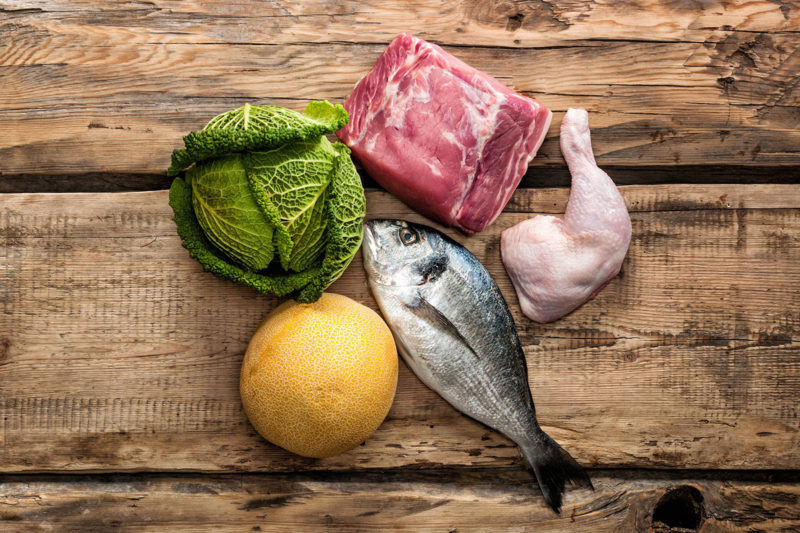Eating to support your metabolic health, which includes aiming for stable blood sugar, isn’t a diet in the sense we think about most diets: prescribed sets of rules about what you can and can’t eat. Instead, we see it as a way of thinking about food that can complement and enhance most dietary approaches, from vegan to paleo.
In this series of articles, we’ll look at what metabolically healthy eating means for people following a particular dietary approach: what questions you may have, how the two can work together, and what you might add to your existing plan to improve your overall health.
Here, we discuss the Paleo diet — why it has proved so popular over the last decade, and how adding a metabolic mindset can help offset the challenges and downsides of primal eating and make it more practical for the modern world.
What is Paleo eating again?
The Paleo diet first rose to popularity in the early 2010s, introduced by a professor named Dr. Loren Cordain in a book called The Paleo Diet. By 2013, an estimated 1% of Americans (3 million or more) declared themselves Paleo followers, and ‘paleo’ was the most-searched diet term on Google. By 2019, related primal-eating approaches such as ketogenic, carnivore, and Whole30 diets competed with Paleo, but a 2020 study suggests many people remain adherents.
The basic premise of Paleo is simple: if Paleolithic peoples (i.e., cavemen and women) didn’t eat it, then you shouldn’t either. That means loading up on meats, fish, fruits, vegetables, nuts and seeds, and eschewing industrial-age “food products” such as refined sugars, breads, and pastas. Avoiding processed food is, of course, an edict common to many whole-food eating plans. But strict Paleo eaters also reject foods of the post-agricultural era, avoiding milk, cheese, lentils, beans, potatoes, and cultivated grains.
In practice, Paleo diets can vary considerably. There are high-fat, low-carb Paleo variants that mimic Paleo-Arctic eating patterns, but also high-carb, low-fat variants rich in starchy cassava and cornmeal—as still enjoyed by the !Kung and extant hunter-gatherer tribes today. As advocates like to point out, there is no one way to do Paleo, one of its many strengths as a dietary approach.
So is primal eating good for us?
While the scientific backing for Paleo is somewhat mixed, it seems fair to say that for many people, eating like a caveman can yield some specific and immediate benefits to health. Multiple studies have found that following a strict Paleo diet can lead to substantial weight loss and improved Body Mass Index. One two-year randomized control study in Sweden followed 70 obese, postmenopausal women. It showed that those on a strict Paleo protocol lost an average of around 15 pounds during the first six months (versus about 5 pounds for a control group on a standard, grain-heavy Nordic diet). A more recent 2019 meta-analysis reinforced this finding, showing small but statistically significant differences in average weight loss, waist circumference, and BMI between Paleo and standard recommended diets in three countries.
Other small studies have suggested that the Paleo diet can improve blood pressure, triglyceride levels, total circulating cholesterol, and various other risk factors for chronic cardiovascular disease—at least in healthy populations. Still, others cite the positive effects of Paleo on glucose tolerance and insulin sensitivity, something not to be sniffed at, given the growing incidence of metabolic syndrome and Type 2 diabetes worldwide.
But despite these purported upsides, many scientists still question the validity of the Paleo approach on both theoretical and practical grounds.
Why would anyone be against eating only whole, natural foods?
It’s not the whole-food part that seems to be in contention, so much as what constitutes “natural” foods for humans, be they Paleolithic or Modern. Recent anthropological evidence suggests that many of our Paleolithic ancestors (including Neanderthals) were vegetarian, pounded wild-grown barley into flour, and ate cooked grains as a regular part of their diet. And for their part, Stone Age tribes in Britain have been consuming milk and cheese for nearly 9,000 years, suggesting that our modern dairy habit may actually be Paleolithic (or at the very least, early Neolithic) in origin. Taken together, say anthropologists, these findings imply that modern ‘Paleo’ dieters are almost certainly excluding foods that were quite available to—and widely eaten by—actual Paleolithic peoples.
Quite apart from this, some biologists like to point out that humans have evolved and adapted in the 12,000-year interim since the Paleolithic age—as have the animals we like to eat. The fat Wagyu cattle that provided your marbled Kobe beef steak look nothing like the scrawny, bovine aurochs hunted and herded by our ancestors. Organic cabbage, cauliflower, broccoli, and kale were all cultivated within the last few thousand years (incidentally, from the same wild mustard plant). Brussels sprouts? They were born in medieval Europe rather than Paleolithic Eurasia.
So attempting to eat a truly “Paleolithic” diet, say scientists, is both historically questionable and practically unfeasible in the modern age. As to the apparent benefits of Paleo, most—if not all—of them are likely due to the single step of cutting out highly processed and high-sugar foods.
Okay, but if Paleo makes people healthier, who cares if it’s historically accurate?
A fair point, and one often argued by enthusiasts. Whether prehistoric precedent or modern invention, if the Paleo philosophy helps create better dietary choices—such as eating whole foods and avoiding multi-ingredient “convenience” foods packed with excess sugar and fat—then why not just celebrate the positives?
For many, the answer to that question may depend on how you apply the Paleo rules and how long you plan to follow them.
On the one hand, having a simple heuristic (or rule of thumb) for eating, like “eat only natural, unprocessed foods,” can simplify choices and make healthy eating patterns more sustainable. As an example of this, see author Michael Pollan (The Omnivore’s Dilemma, In Defense of Food) and his simple food rules: Eat Real Food; Not Too Much; Mostly Plants.
On the other hand, trusting in arbitrary “natural eating” principles alone—in the absence of portion control, micronutrient content, or other forms of food awareness—may still allow for over-consumption in general or under-consumption of particular micro and macronutrients. Especially when Paleo foods like meat and nuts are now available in quantities that would have required several weeks (and thousands of expended calories) to hunt or gather in Paleolithic times.
Excess fat consumption has been linked, again and again, to adverse health outcomes such as weight gain, insulin resistance, and susceptibility to atherosclerotic cardiovascular disease (ACVD), and neither we nor our ancient ancestors are impervious to its long-term effects.
To underline this, one fascinating Lancet study in 2013 looked at atherosclerosis across ancient populations in Egypt, Peru, and the Aleutian Islands, using whole-body CT scans to scan preserved bodies (i.e., mummies). They found blocked, calcified arteries in 34% of all the mummies, and the age at the time of death (mean age: 43) highly correlated with the extent of atherosclerosis shown.
Modern research around the long-term health consequences of frequent red meat consumption is mixed (a recent study found it may be associated with a longer lifespan). Still, there is a reasonable case that it increases cardiovascular risk (moreso for processed meat), so quality and portion control likely still matter.
But with lean meats in reasonable portions, Paleo can still be healthy long-term, right?
It certainly can be. But in excluding all grains and legumes, Paleo eaters may be throwing out a healthy baby with their post-agricultural bathwater.
Strict Paleo diets exclude whole grains that may (in moderation) be beneficial for heart and gut health. And ancient humans may have begun eating them as far back as 3-4 million years ago, before the Paleolithic era even began, and were certainly doing so during the latter part of the Paleolithic Period, a.k.a. the Old Stone Age. Many Paleo enthusiasts claim that grains contain little nutritional value while harboring antinutrients, molecules that prevent the absorption of iron and other micronutrients. Yet Paleo-approved nuts and leafy greens also contain antinutrients and in even more significant amounts.
Grainless Paleo diets may also lack the requisite amount of dietary fiber, which serves multiple roles in healthy nutrition and digestion. Among other things, fiber delays absorption in the stomach (making you feel fuller for longer), improves insulin sensitivity, assists the production of beneficial fatty acids, and promotes the growth of a healthy, varied gut microbiome.
Most Paleolithic peoples ate energy-poor and fiber-rich foods as a matter of necessity. Yet somewhat ironically, many modern Paleo dieters consume a diet that is both energy-rich and fiber-deficient. Paleo-fans counter that you can obtain fiber from other sources, like chia seeds and avocados, without resorting to grains and beans. Or simply supplementing with pre-made powders and solutions. Regardless, if you are maintaining a Paleo diet long-term, then getting enough fiber should be something to at least consider.
Apart from the fiber question, an aversion to whole grains and dairy can leave Paleo dieters with insufficient calcium, thiamin, riboflavin, and other essential micronutrients, predisposing them to osteoporosis, rickets, and other conditions related to nutrient deficiency.
And as with all meat-heavy eating plans, if you are not especially picky about the quality of your meat long-term, you not only risk excess fat consumption, you also face more exposure to carcinogens and pro-inflammatory compounds. Insulin-Like Growth Factor 1 (or IGF-1) is a prime culprit and seems to pose more of a threat to younger meat-eaters (those under 65 years) versus older ones.
In short, strict adherence to Paleo may force you to accept the trade-off of short-term weight loss and metabolic health for compromised gut health, immunity, and cancer susceptibility.
But if you’re not too puritanical about it, then the flexibility of the Paleo diet still allows a good amount of tweaking and optimizing—which is where eating for metabolic health comes in.
So what is eating for metabolic health?
Eating for metabolic health goes a step beyond thinking about food as simply an energy source. It also considers how food interacts with the systems in our body that produce and store energy and keep our cells running smoothly. Generally speaking, that means selecting foods that do not cause large spikes in blood glucose and insulin and opting instead for foods that help maintain a stable and healthy glucose range throughout the day.
Poor metabolic health, as evidenced by large swings of blood glucose and poor insulin sensitivity, is associated with poor outcomes in (among other things) brain health, skin health, fertility, energy and mood levels, and susceptibility to a wide range of chronic diseases.
Close to 90% of Americans show some form of metabolic dysfunction, as evidenced by poor insulin sensitivity, pre-diabetes, or other forms of metabolic dysfunction. Those subscribing to whole food dietary philosophies (including Paleo eaters) may do better than those on the high-sugar, highly-processed Standard American Diet (“SAD” being the appropriate acronym) in terms of metabolic health.
Taken as a whole, the Paleo diet seems to fare about as well as other healthy diet approaches (such as low-carb and Mediterranean) in terms of glucose and insulin homeostasis and of predisposition to diabetes. The authors of the study above suggest, “The lack of differences between the effect of the Paleolithic diet and control diets on glucose concentrations observed in this meta-analysis might be partly explained by the negative effect of the Paleolithic diet on microbiota composition.”
So if Paleo is good for glucose, how can eating for metabolic health help enhance it?
Eating for metabolic health means thinking about food not according to strict rules but instead seeing food as information for your body, the literal building blocks of your cells and keys to critical processes.
For Paleo eaters, eating for optimal metabolism may help you reintroduce beneficial foods without sabotaging your whole-food health gains. Just as Flexitarians add a little meat or fish to augment a vegan or vegetarian diet, Paleo dieters adding the metabolic health mindset may enjoy the best of both worlds by introducing grains or legumes in controllable quantities. By figuring out how specific foods affect your unique metabolic predispositions, you might:
- time your carb intake for more optimal satiety and energy release;
- limit your sugary fruit intake in favor of starchy, fibrous vegetables;
- improve your fiber and micronutrient intake through select farmed foods, removing the need for daily supplementation;
- enjoy the occasional chia seed pudding in place of the relentless omelet breakfast.
Once you have the principles, you can craft a truly balanced and sustainable approach to eating that honors Paleo eating ideals and the necessities of daily living.
Choosing a natural, whole-food diet more in keeping with our primal roots is a good idea in principle. Eating for metabolic health can help make it practical for the modern world.
When all is said and done, the Paleo diet is designed to right a fundamental wrong: the modern, post-industrial diet is heavily processed and reliant on grains, sugars, and modified fats. Because of this, for most people, switching from a standard modern-industrial diet to a Paleo diet will mean:
- a decrease in sugar and fat consumption
- an increase in vegetable intake,
- significant benefits to metabolic, cardiovascular, and gastrointestinal health
But these benefits likely depend on doing Paleo right. That means keeping it largely plant-centric and eating a wide variety of fresh, whole foods. If your “primal” eating plan allows for limitless bacon and processed, pseudo-Paleo snack bars, then it really isn’t primal at all. Misconception and misapplication are the real dangers here, rather than basic principles. Finally, since dietary needs and metabolic responses vary widely between individuals, the Paleo diet may need some tweaking and optimizing to make it genuinely optimal for you. So whether you’ve been thinking of starting a Paleo diet or following primal-eating principles for years, eating for metabolic health can help you stay on track, calibrate your approach, and reap the benefits (versus the wheat products) for the long term.







